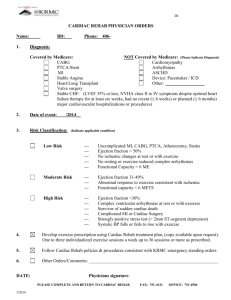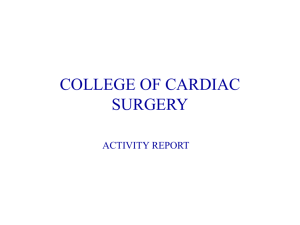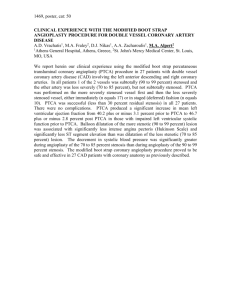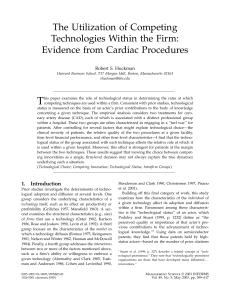P E R S P E C T I V...
advertisement
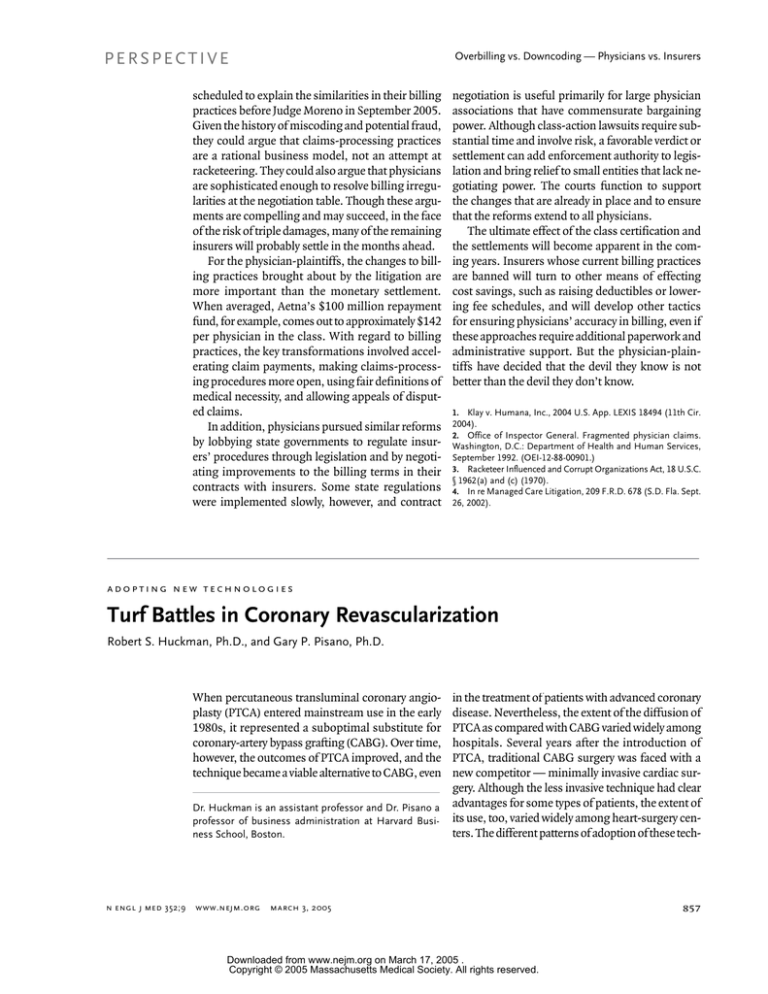
Overbilling vs. Downcoding — Physicians vs. Insurers PERSPECTIVE scheduled to explain the similarities in their billing practices before Judge Moreno in September 2005. Given the history of miscoding and potential fraud, they could argue that claims-processing practices are a rational business model, not an attempt at racketeering. They could also argue that physicians are sophisticated enough to resolve billing irregularities at the negotiation table. Though these arguments are compelling and may succeed, in the face of the risk of triple damages, many of the remaining insurers will probably settle in the months ahead. For the physician-plaintiffs, the changes to billing practices brought about by the litigation are more important than the monetary settlement. When averaged, Aetna’s $100 million repayment fund, for example, comes out to approximately $142 per physician in the class. With regard to billing practices, the key transformations involved accelerating claim payments, making claims-processing procedures more open, using fair definitions of medical necessity, and allowing appeals of disputed claims. In addition, physicians pursued similar reforms by lobbying state governments to regulate insurers’ procedures through legislation and by negotiating improvements to the billing terms in their contracts with insurers. Some state regulations were implemented slowly, however, and contract negotiation is useful primarily for large physician associations that have commensurate bargaining power. Although class-action lawsuits require substantial time and involve risk, a favorable verdict or settlement can add enforcement authority to legislation and bring relief to small entities that lack negotiating power. The courts function to support the changes that are already in place and to ensure that the reforms extend to all physicians. The ultimate effect of the class certification and the settlements will become apparent in the coming years. Insurers whose current billing practices are banned will turn to other means of effecting cost savings, such as raising deductibles or lowering fee schedules, and will develop other tactics for ensuring physicians’ accuracy in billing, even if these approaches require additional paperwork and administrative support. But the physician-plaintiffs have decided that the devil they know is not better than the devil they don’t know. 1. Klay v. Humana, Inc., 2004 U.S. App. LEXIS 18494 (11th Cir. 2004). 2. Office of Inspector General. Fragmented physician claims. Washington, D.C.: Department of Health and Human Services, September 1992. (OEI-12-88-00901.) 3. Racketeer Influenced and Corrupt Organizations Act, 18 U.S.C. § 1962(a) and (c) (1970). 4. In re Managed Care Litigation, 209 F.R.D. 678 (S.D. Fla. Sept. 26, 2002). adopting new technologies Turf Battles in Coronary Revascularization Robert S. Huckman, Ph.D., and Gary P. Pisano, Ph.D. When percutaneous transluminal coronary angioplasty (PTCA) entered mainstream use in the early 1980s, it represented a suboptimal substitute for coronary-artery bypass grafting (CABG). Over time, however, the outcomes of PTCA improved, and the technique became a viable alternative to CABG, even Dr. Huckman is an assistant professor and Dr. Pisano a professor of business administration at Harvard Business School, Boston. n engl j med 352;9 www.nejm.org in the treatment of patients with advanced coronary disease. Nevertheless, the extent of the diffusion of PTCA as compared with CABG varied widely among hospitals. Several years after the introduction of PTCA, traditional CABG surgery was faced with a new competitor — minimally invasive cardiac surgery. Although the less invasive technique had clear advantages for some types of patients, the extent of its use, too, varied widely among heart-surgery centers. The different patterns of adoption of these tech- march 3, 2005 Downloaded from www.nejm.org on March 17, 2005 . Copyright © 2005 Massachusetts Medical Society. All rights reserved. 857 Turf Battles in Coronary Revascularization B.D. Colen/ADIOL PERSPECTIVE niques point to the critical role of organizational factors in the adoption of new medical technology. Studies of innovation suggest that the adoption of innovative techniques and methods involves three phases. The first phase is exposure to information about the innovation (in publications, at conferences, in advertising, and over the Internet); the second, the initial choice of physicians and patients to try out the innovation, in a complex process that involves both objective and subjective evaluations of its comparative merits; and the third, learning, in a process by which organizations and people adapt in order to use the innovation successfully. It is useful to distinguish exposure, choice, and learning from one another in order to perceive the points where adoption can fail. During the past 20 years, increasingly aggressive marketing practices, direct-to-consumer advertising, and the Internet have made a plethora of information available to would-be adopters of medical innovations. Although the quality of all the information now available is variable, lack of exposure to innovation is no longer the chief bottleneck in the adoption process. Instead, many of the problems occur in the choice and learning phases. Adoption is a competitive process. Much of the competition takes place among the developers and among the marketers of innovations, but it does not end at the front door of the hospital. The variability in the patterns of adoption at different hospitals suggests that subtle competitive forces are at work inside the hospital walls. 858 The most obvious requirement for wide adoption of a medical innovation is that physicians should be willing to use it instead of existing techniques. Often, the benefits of a new technique are obvious. For example, surgeons quickly saw laparoscopic cholecystectomy as superior to conventional surgery, and they therefore switched to the new procedure in a speedy and relatively consistent fashion. In other cases, the benefits of new procedures are not so clear. Early after the introduction of PTCA, the market for the treatment of cardiac disease remained segmented according to the severity of disease: patients with less severe disease underwent PTCA performed by cardiologists, and those with more severe disease underwent CABG performed by cardiac surgeons. This entente cordiale was supported by the widely held view that PTCA was less effective than CABG in the treatment of advanced disease. But as cardiologists gained experience with PTCA, long-term outcomes in patients with disease in one or two vessels were increasingly similar for the two procedures. As a result, many institutions began facing turf wars between interventional cardiologists and cardiac surgeons for access to patients. Ideally, gently fought turf wars will lead to the diffusion of a more efficient innovation in lieu of a less efficient alternative. In many hospitals, however, the battle over competing techniques is not fought on a level playing field, because the use of one of them has become entrenched and its users have gained influence within the hospital. Given that CABG entered mainstream use more than 10 years before PTCA, cardiac surgeons had a head start on invasive cardiologists in positioning themselves as important sources of both procedure volume and profit for their hospitals. As a result, surgeons were able to influence hospital decisions that could slow the diffusion of PTCA at their institutions — by garnering greater funding for the recruitment of cardiac surgeons than for the recruitment of invasive cardiologists, for instance, or by insisting on greater investment in dedicated operating rooms for CABG than in catheterization laboratories for PTCA. In hospitals in which cardiac surgeons are highly influential, as indicated by the number of citations of their work in the academic literature, PTCA has been used less frequently than in hospitals with less influential surgeons. This association is not n engl j med 352;9 www.nejm.org Downloaded from www.nejm.org on March 17, 2005 . Copyright © 2005 Massachusetts Medical Society. All rights reserved. march 3, 2005 Turf Battles in Coronary Revascularization B.D. Colen/ADIOL PERSPECTIVE explained by the clinical characteristics of the patients, the financial or organizational characteristics of the hospitals, or the quality of the cardiac surgeons (measured by risk-adjusted mortality rates for CABG) as compared with the cardiologists (measured by risk-adjusted rates of emergency CABG after PTCA).1 Even when a new medical technique makes it past influential gatekeepers, some forms of adaptation and learning, often by teams of providers, are required. This challenge can be particularly difficult to meet when the technique in question disrupts existing work routines and patterns of interaction among professionals. Having examined detailed operative histories of the first 660 patients who underwent minimally invasive cardiac surgery (in 16 hospitals), we found that learning could be measured in multiple ways. These include reductions in the time required for a procedure, increases in the complexity of the operations performed with the technique (e.g., singlevessel bypass vs. multiple-vessel bypass), and subjective evaluations by providers of the overall success of implementation. Although there was evidence of substantial learning with respect to minimally invasive surgery, there were significant differences among hospitals in the pace at which learning occurred. For instance, after using the technique in 20 cases, the team that learned most rapidly reduced the time required for the procedure by 42 percent (adjusted for the com- n engl j med 352;9 www.nejm.org plexity of cases), as compared with a reduction of 28 percent for the same procedure performed by the average team.2 Such differences have a critical effect on the willingness and ability of both surgeons and hospitals to continue to use a technique. Hospitals that had trouble reducing the procedure time to economically viable levels were more likely to abandon the innovation than those that rapidly reduced the time. Certain organizational factors drive these differences. First, team stability matters. Learning is fostered by keeping teams intact for set periods. Second, the learning climate at a hospital plays an important role. Learning anything new in a group setting involves interpersonal risk, particularly for junior or lower-status team members, who may worry about the consequences of making mistakes or speaking up when they see opportunities for improving performance. In environments that are characterized by high levels of “psychological safety,”3 team members feel comfortable addressing these issues — and such comfort, in turn, facilitates the flow of information and frank feedback on performance, thereby promoting learning. In the context of minimally invasive cardiac surgery, psychological safety depended on the surgeon who led the team: in the most successful hospitals, this surgeon was extensively involved in selecting the team, framing the implementation challenge as a team project, and inviting input from all team members. This experience sheds new light on the idea of learning curves in health care. Although, on average, experience matters, not all organizations are equally adept at exploiting their experience. Whereas individuals may be endowed with natural abilities to learn, organizations are not; organizational learning occurs only when it is actively managed. Ultimately, the success of adoption is determined not solely by the objective characteristics of a technique — its functions, speed, or precision — but also by the process by which it is integrated into an organization. 1. Huckman RS. The utilization of competing technologies within the firm: evidence from cardiac procedures. Manage Sci 2003;49: 599-617. 2. Pisano GP, Bohmer RMJ, Edmondson AC. Organizational differences in rates of learning: evidence from the adoption of minimally invasive cardiac surgery. Manage Sci 2001;47:752-68. 3. Edmondson AC. Psychological safety and learning behavior in work teams. Adm Sci Q 1999;44:350-83. march 3, 2005 Downloaded from www.nejm.org on March 17, 2005 . Copyright © 2005 Massachusetts Medical Society. All rights reserved. 859
